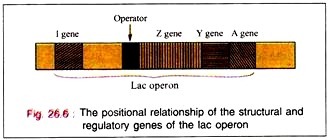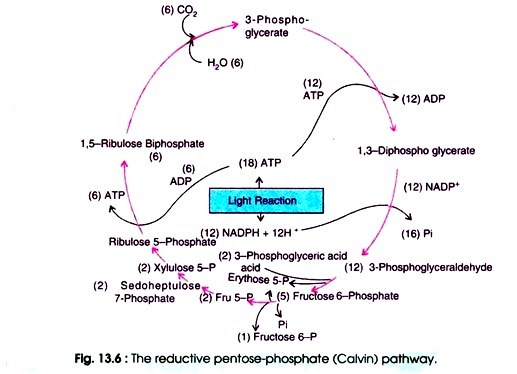In this article we will discuss about the mechanism of bacterial photosynthesis.
The absorption of light is by a pigment molecule which after absorption delivers the energy to electron carriers that can transduce the energy into chemical form. The function of chlorophyll molecule is absorption of photons. The energy contained in the excited pigments is channelled through light-harvesting pigments (also called-antenna molecules) into the reaction centre in which photochemical reactions take place.
From this reaction centre, high energy electrons are released. The reaction centre consists of 4 bacteriochlorophyll molecules. Out of four, two bacteriochlorophyll molecules participate in absorption of light and transfer it to an electron.
Such molecules are called special pair. The other two bacteriochlorophyll molecules appear to be inactive. After excitation, electrons are released and thus bacteriochlorophyll becomes positively charged.
The electron is now transferred to an iron-containing heme protein called ferredoxin, and here electron moves to ubiquinone, to cytochrome b, and to cytochrome f (old name cyt c) and finally accepted by the positively charged bacteriochlorophyll. The energy is released between cytochrome b and cytochrome f is used for photo-phosphorylation (Fig. 13.4).
During the cyclic photophosphorylation, ATP is produced but no NADP+ has been reduced in these reactions. Such a process occurs in Rhodopseudomonas sphaeroides, R.capsulata, Chromatium vinosum and Chlorobium thiosulphatophilum.
During the non-cyclic photophosphorylation, two molecules of ATP are produced, NADP+ is reduced and oxygen is produced by photolysis of water. Such a process is found in plants, algae and oxygenic photosynthetic bacteria i.e. cyanobacteria.
In this act, when pigments of PS II absorb light, electrons are released from this system, thus chlorophyll molecules get oxidised. The components of light – harvesting can be influenced by environmental factors such as light, availability of sulphur and phosphorus. Oxidised pigments, take electrons from OH” ions and are again reduced and hydroxyl radical (OH–) is left from OH– ions.
Four OH– radicals give rise to 2 molecules of water and 1 molecule of oxygen. Hydrogen atom (H+) released in this process are used for the reduction of NAD (through FADH2). In this process manganese ions have a special role to play but chloride and bicarbonate are also helpful. Formation of 1 atom of oxygen and 4 electrons at least four quanta of light are needed.
Electrons getting from bacteriochlorophyll molecule of PS II, reduce a substance Q the quencher of PS II whose chemical nature is not known. From reduced ‘Q’, high energy electrons are transferred to another unknown substance ‘B’, then to plastoquinone. From reduced plastoquinone (PQH), electrons moved to cytochrome-f which gets reduced.
From reduced cytochrome-f, electrons are taken by plastocyanin (PC), which is thus reduced. From reduced plastocyanin, electrons are accepted by oxidised P870. In this way, plastocyanin works as a plug between photoact II and photoact I. Electrons from water are passed on to NADH.H (Fig. 13.5)
In the non-cyclic photophosphorylation, high energy electrons are accepted by PS I, from where electrons are accepted by A (Fe S), these electrons thereafter moved to ferredoxin (Fd), the Fd is oxidised from reduced Fd, the electrons are taken by FAD+ which gets reduced to FADH2 (here hydrogen comes from photolysis of water), electrons and protons (Hydrogen) are accepted by NADP and its get reduced to NADH2 as shown in Fig. 13.6.
There are three main steps of Calvin cycle:
(i) Carboxylation,
(ii) Reduction, and
(iii) Regeneration involved in the CO2 reduction in the Calvin cycle.
In the reduction process, enzyme ribulose bisphosphate carboxylase (rubisco) participates in a reaction between CO2 and rebulose bisphosphate to form two molecules of 3-phosphoglyceric acid (PGA).
In this one molecule contains the carbon atom from CO2 which is in the same oxidation level as it is in CO2 rest two carbon atoms from ribulose bisphosphate. This step is followed by reduction of PGA. In this process, both ATP and NADH are required. ATP involves in the phosphorylation that activates the carboxyl group of PGA whereas NADH gets reduced itself.
This step is the reversal of glycolytic step except that here NADH is involved (not NADH). Thus, reduction level of glyceraldehyde’s phosphate is at same reduction level of carbohydrate. In the third step reactions are involved to regenerate ribulose bisphosphate molecules with the help of recently fixed CO2.
The hydrogen attached to NADPH2 is used for CO2 reduction in dark reaction (Calvin cycle). The NADPH2 is called reducing power of the cell. It appears that PS II alone can carry out the entire process of non-cyclic photophosphorylation. Thus, the noncyclic reduction of Fd need not require PS I.



